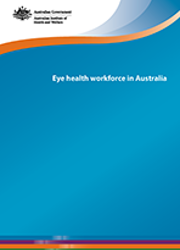Summary
Nearly 12 million Australians (54% of the total population) reported having one or more long-term eye condition in the Australian Bureau of Statistics 2011-12 National Health Survey. A range of occupations are involved in diagnosing and managing these conditions. This report examines the size and characteristics of the eye health workforce (which includes ophthalmologists, optometrists and allied ophthalmic personnel). It updates the analysis provided in Eye health labour force in Australia, August 2009 (AIHW 2009), and provides baseline data for a set of national indicators.
There is no single comprehensive data source on the eye health workforce in Australia, and complete data are not available for all occupations. This report draws on data from the Australian Institute of Health and Welfare's National Health Workforce Data Set for optometrists and ophthalmologists; the Australian Bureau of Statistics' Census of Population and Housing for optical dispensers, orthoptists and optical mechanics; and from professional organisations for orientation and mobility specialists and occupational therapists specialising in eye health.
While these data sources cover several different periods, 2011 is a common year in most, so it is the reference year used for comparison across occupations in the workforce. The baseline year required for the indicators is 2010 so these data are provided as well.
Key findings
In 2011, an estimated 10,916 people were employed in the eye health workforce:
- 4,481 optical dispensers (16.9 full-time equivalent (FTE) per 100,000 population)
- 4,034 optometrists (17.1 FTE per 100,000)
- 828 ophthalmologists (3.9 FTE per 100,000)
- 674 orthoptists (2.5 FTE per 100,000)
- 651 optical mechanics (2.9 FTE per 100,000)
- 158 orientation and mobility specialists (0.6 FTE per 100,000)
- 90 occupational therapists specialising in eye health (0.3 FTE per 100,000).
Optometrists and optical dispensers combined made up the majority of the eye health workforce (78.0%) in 2011. Ophthalmologists had the lowest proportion of females, at 17.4%. The next lowest were optical mechanics, with one-third (32.9%) being female. Around half (47.8%) of all optometrists were female. The other occupations were mostly female.
In 2011, over three-quarters of the eye health workforce worked in Major cities (78.6%), though this varied by occupation, from 74.7% of optical dispensers to 89.9% of optical mechanics. Overall, 70.2% of the Australian population were living in Major cities in 2011.
The eye health workforce grew by nearly 25% between 2006 and 2011. Growth was greatest for optical dispensers (37%). The Australian population grew by almost 29% over the same period.
In 2010, based on Australian Government and World Health Organization definitions, the eye health workforce in Australia was estimated at 11,173 people, comprising 3,899 optometrists, 810 ophthalmologists and 6,464 allied ophthalmic personnel.
Preliminary material: Acknowledgments; Abbreviations; Symbols
1 Introduction
- Eye health workforce
- Structure of the report
2 Data sources and methods
- Data sources
- Methods
3 Eye health workforce
- Overview
- Optical dispensers
- Optometrists
- Ophthalmologists
- Orthoptists
- Optical mechanics
- Orientation and mobility specialists
- Occupational therapists specialising in eye health
- Other occupations
4 Eye health workforce indicators
- Estimates for 2010
5 Future data collection
- Census
- AIHW National Health Workforce Data Set
- Data from professional associations and organisations employing eye health workers
Appendixes
Appendix A: Tables for eye health workforce, 2010 to 2014
Appendix B: Population estimates
End matter: References; List of tables; List of figures; List of boxes; Related publications



